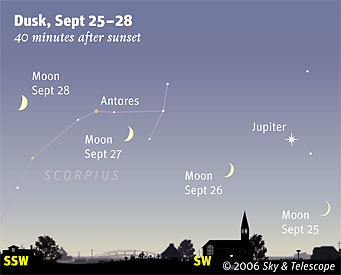
As the waxing crescent Moon thickens, watch it pass Jupiter and Antares at dusk. (European observers: move each Moon symbol a quarter of the way toward the one for the previous date.)
Sky & Telescope diagram
The crescent Moon all by itself is a gorgeous sight when it hangs low above the horizon amid twilight. The scene improves when it's paired with a second bright object. During the next several evenings, as illustrated at right, the Moon will move southward and upward as it waxes toward first-quarter phase on September 30th.
On Monday the 25th, the thin crescent will lie to the lower right of brilliant Jupiter, which shines at magnitude –1.9. Check them again the following night and the Moon — now just a tad thicker — will be to Jupiter's lower left. Use binoculars to look 3° to the lower right of Jupiter, where you'll find Alpha Librae, a wide double star.
As the Moon moves beyond Jupiter, it nears the bright star Antares. At dusk on the 27th, the ruddy star will be to the Moon's upper right. The following evening, the fat crescent lies well to the star's left. Antares is the brightest star in Scorpius. As the celestial Scorpion draws close to exiting the evening sky, it's another clear sign that winter is on its way.
 0
0
Comments
You must be logged in to post a comment.